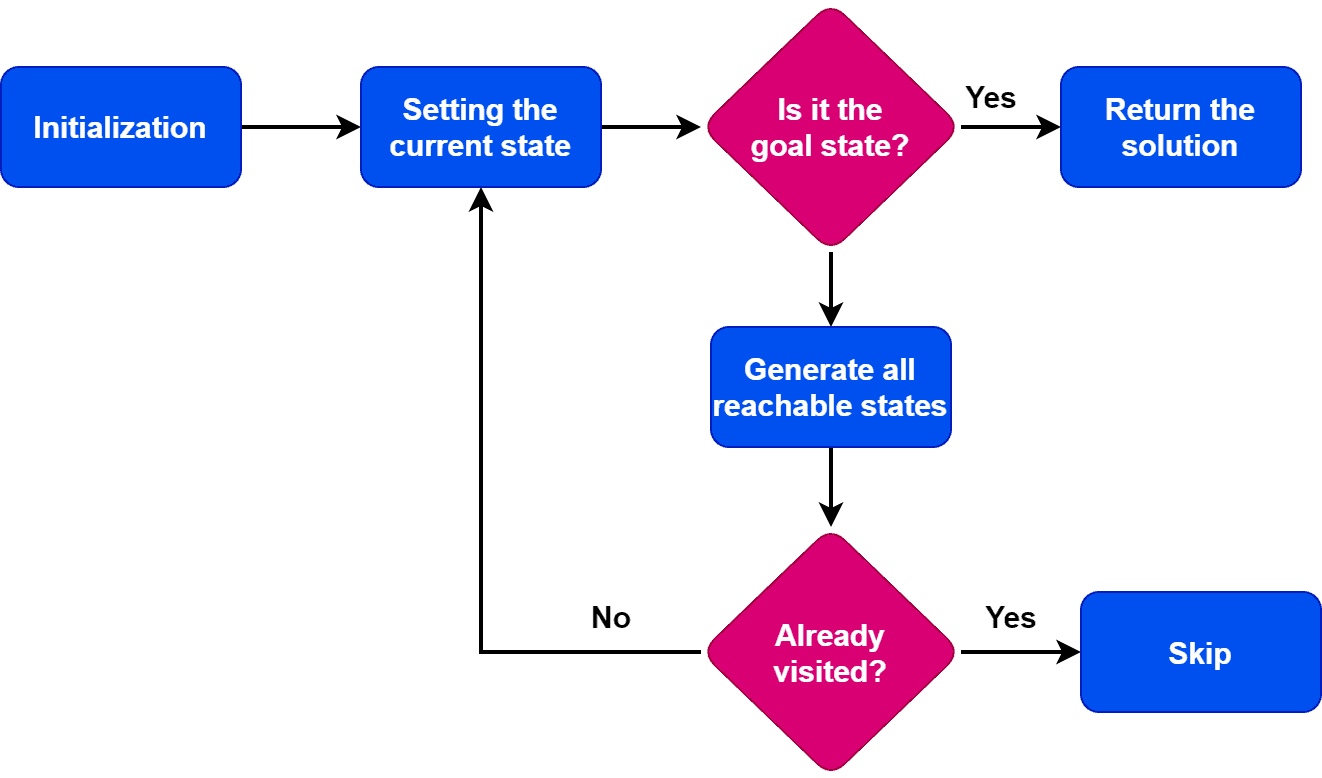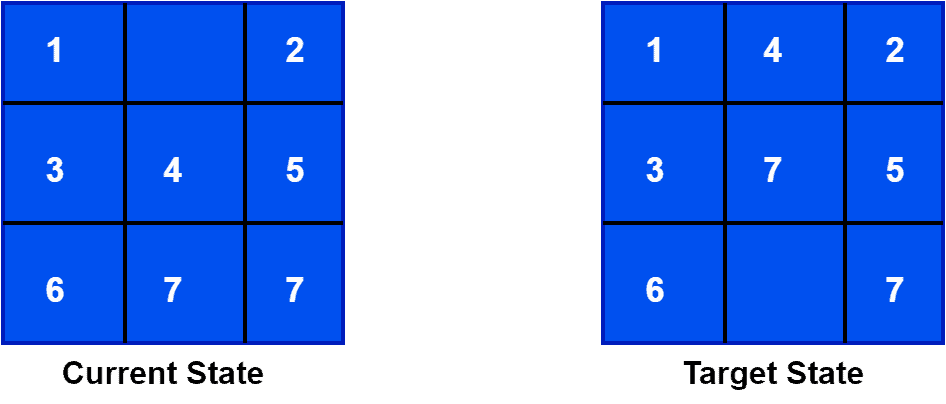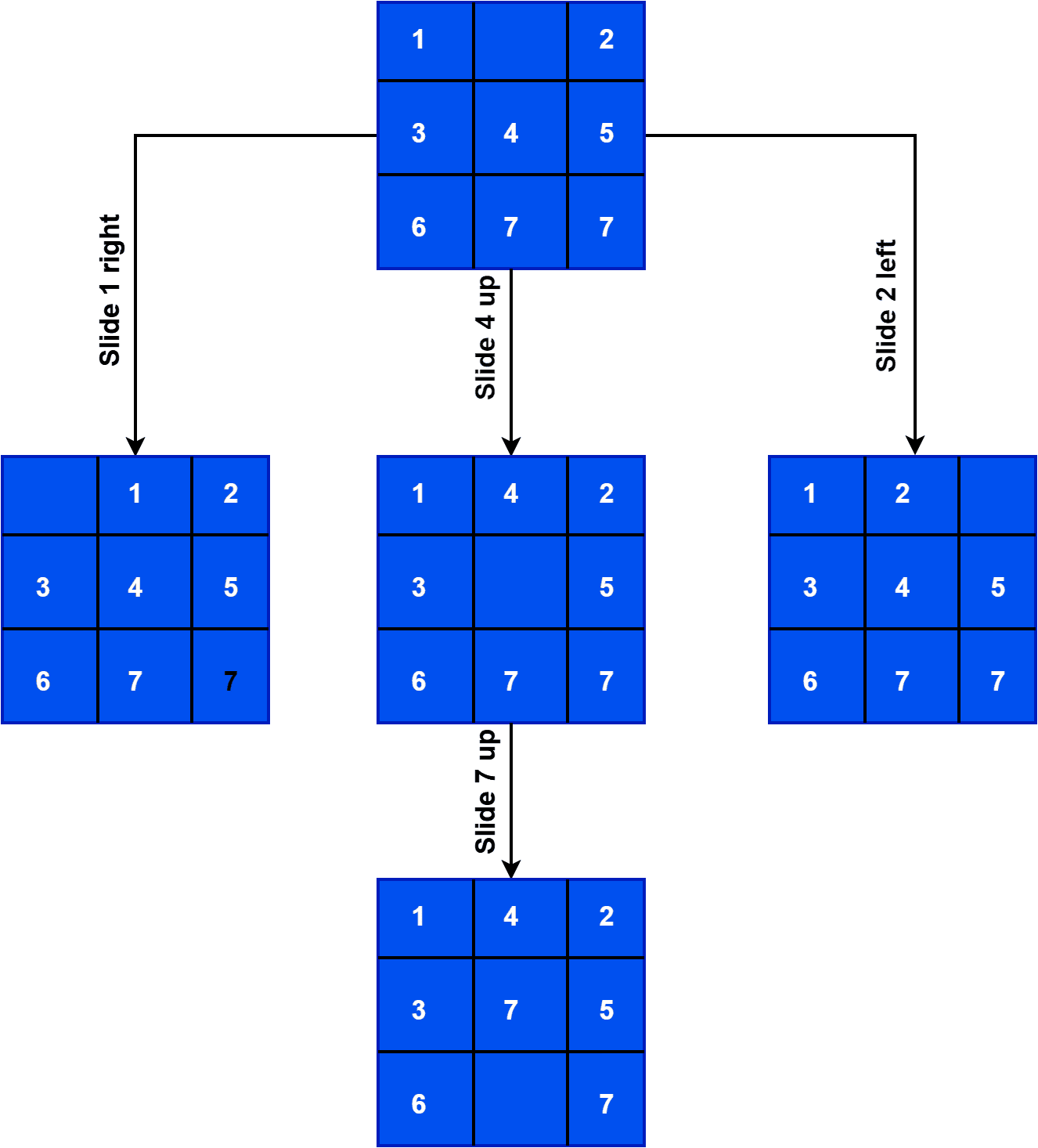1. 概述
在本篇教程中,我们将深入讲解状态空间搜索(State Space Search)这一概念,并通过一个经典问题进行演示。同时,我们也会介绍它在多个领域的典型应用场景。
2. 什么是状态空间搜索
状态空间是一个数学模型,用于表示一个系统或问题可能处于的所有状态。在搜索算法中,我们用它来表示问题的初始状态、目标状态以及中间的所有可能状态。每个状态通常由一组变量来描述。
✅ 状态空间搜索是一种广泛应用于人工智能和计算机科学中的方法,其核心思想是从初始状态出发,通过一系列可能的操作逐步探索,最终到达目标状态,从而解决问题。
状态空间的大小对搜索效率有显著影响。因此,选择合适的状态表示方式和搜索策略至关重要。
一些常见的状态空间搜索算法包括:
- A* 算法 ✅
- 广度优先搜索(BFS) ✅
- 深度优先搜索(DFS) ✅
- 爬山法(Hill Climbing) ✅
- 模拟退火(Simulated Annealing) ✅
- 遗传算法(Genetic Algorithms) ✅
这些算法在不同场景下各有优劣,适用于不同类型的问题。
3. 状态空间搜索的基本步骤
以下是一个典型状态空间搜索算法的流程:

- 初始化:将初始状态设为当前状态。
- 判断当前状态是否为目标状态:
- 是:返回结果并终止。
- 否:继续下一步。
- 生成后继状态:根据当前状态生成所有可能的下一步状态。
- 检查是否已访问过这些状态:
- 已访问:跳过。
- 未访问:加入待访问队列。
- 从队列中取出下一个状态作为当前状态,重复步骤2。
- 如果所有状态都已尝试但未找到目标状态,则返回“无解”。
⚠️ 实现细节因问题而异,算法性能也高度依赖于数据结构的选择,比如使用队列还是栈、是否使用哈希集合记录已访问状态等。
4. 示例:8 数码问题(8-Puzzle)
8 数码问题是状态空间搜索中非常经典的一个例子。它由一个 3×3 的格子组成,其中 8 个格子是数字 1~8,还有一个空格(通常用 0 表示)。目标是通过滑动数字,将初始状态变为目标状态。
状态表示
每个状态可以用一个 3×3 的二维数组表示,例如:
int[][] initialState = {
{1, 2, 3},
{4, 0, 5},
{7, 8, 6}
};
int[][] goalState = {
{1, 2, 3},
{4, 5, 6},
{7, 8, 0}
};
状态转移
每次移动空格上下左右四个方向之一,生成一个新的状态。例如,从初始状态出发,空格可以向上、下、左或右移动(视空格位置而定)。
搜索策略选择
- 广度优先搜索(BFS):可以保证找到最短路径,但效率较低,尤其在状态空间庞大时。
- A* 算法:结合启发式函数(如曼哈顿距离),可以更高效地找到最优解。
示例图示
当前状态:

目标状态:

通过状态空间搜索,我们可以找到从当前状态到目标状态的一系列合法移动。
5. 应用场景
状态空间搜索在多个领域都有广泛应用,以下是几个典型应用方向:
✅ 人工智能与机器人
- 路径规划(Pathfinding):如 A* 常用于游戏 AI 寻路。
- 动作规划(Action Planning):机器人根据当前状态规划最优动作序列。
- 策略决策:在博弈类游戏中评估最佳下一步。
✅ 网络与通信
- 路由优化:如 Dijkstra、Bellman-Ford 等算法本质也是状态空间搜索。
- 资源分配:在分布式系统中寻找最优资源调度方案。
✅ 运筹学与优化
- 调度问题:如任务调度、时间安排等。
- 组合优化:如旅行商问题(TSP)。
✅ 生物信息学
- 蛋白质结构预测:通过状态空间搜索模拟蛋白质折叠。
- 基因序列比对:寻找最优比对路径。
✅ 密码学
- 密钥破解:在密钥空间中搜索可能的密钥。
- 密码分析:利用状态空间建模分析加密算法。
✅ 物流与供应链
- 路径规划:配送路径优化。
- 库存调度:优化货物流转路径。
6. 总结
本文我们详细介绍了状态空间搜索这一核心概念,包括其定义、基本流程、示例(8 数码问题)以及多个领域的实际应用。
✅ 状态空间搜索的核心在于将问题抽象为状态转移图,并通过合适的搜索策略高效地找到解。
✅ 不同算法适用于不同类型的问题,选择合适的搜索策略是关键。
✅ 它不仅在 AI 领域有广泛应用,也在运筹学、生物信息学、密码学等多个领域发挥着重要作用。
掌握状态空间搜索的思想,对于解决复杂系统中的路径查找、决策优化等问题具有重要意义。